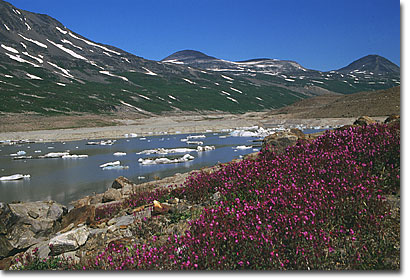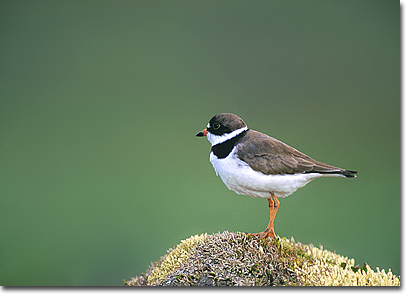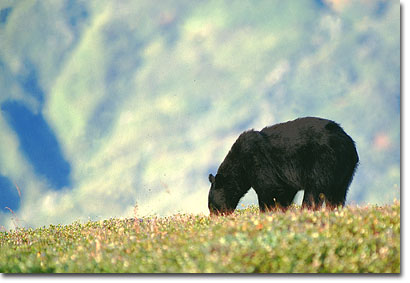|
|
 Nature Photography: Under the Boardwalk!
Text and photography Copyright Carl Donohue
The wilderness is about authenticity. It's not subjective, it's not a perspective, and it's not plastered with billboards. It's reality. Yet we tend to avoid it like the plague, mustering together, shepherding ourselves off to nearby "nature centers," those trusted locales where we know our subjects are easily observed, where we don't have to study their habits or movements, we simply concentrate instead on locating a pleasing ethereal background for our portraits. There's a world of wilderness outside, yet so often we're queued up behind one another, waiting our turn, to shoot from the footprints of the photographer in front of us, where our most difficult assignment is to attract the subject's attention and capture the eye. The internet, with its far-reaching trails of information, is putting photographers from all over the world side by side, as shooters stand elbow to elbow and photograph the "wildlife." Stacked on top of each other, shooting the same subject from the same place, our pursuit of a fresh perspective is often lost amidst a whirlwind of technological gadgetry: hyper-fast auto focus, flash extenders, saturated films, powerful motor drives capable of 8 and 9 fps, and the latest digital camera bodies navigate for us. We follow their lead unerringly, our artistic pursuits being directed by some whiz kid working in R&D. Certainly, employ these tools, but broaden your artistic pursuits, reach a little further, and look beyond such sanctuaries. Cultivate your passion for nature, become more involved with the wilderness. Remove yourself from the trappings of humanity's imposition, and capture nature's essence with a diversity, a spirit and a reality that is not only eye opening, but rewarding beyond imagination. Nature photography is about exploration, it's about creating images of our adventures, and the exotica we experience. To most viewers, what appeals most about our work is that it represents something that they don't typically witness. Standing on a boardwalk in your local nature center doesn't represent that at all. It's similar to being an early-rising tourist with an expensive camera. Nature photography can be so much more than a close-up portrait of a subject, with little or no other point of interest. I've always likened it, especially wildlife photography, to hunting, a camera being our weapon, and film our ammunition. As with hunting, the thrill of the chase is as fundamental as the kill. To study, to seek and stalk a subject, with the patience to wait until the light, the subject, the photographer and the conditions come together at that "absolute moment" is what I believe to be the very essence of nature photography. Photographing the wilderness is as much an expression of the artist as it is the subject. Many theorists argue that art is more about the process than the product. Taking this a step further, to immerse oneself into the living breathing wild, to attune oneself to the pulsating wilderness that we're endeavoring to portray results not only in a more expressive representation, it provides an experience upon which we can better develop our artistic character. Shooting a grizzly bear from the safety of a platform at Brooks Falls, Katmai National Park, holds nothing like
Nature photography is about so much more than composition, exposure, and technological advances in equipment. Too often, I believe, nature photographers prefer to shoot from platforms and boardwalks, at whatever preserve or nature center is in vogue this month, filming habituated animals that will, at a given point in time, parade by. Without question, such a pursuit often results in unparalleled imagery, offering perspectives that simply can't be matched in the wild. However, it's akin to fishing at a trout farm; easy to bring home dinner, but somewhere along the way the aesthetic of the pursuit was altered. It also raises both ethical and artistic questions. Rarely does such an image portray or offer a viewer the circumstances under which it was taken. The focus of such a craft is often the "technique" of the image, without regard to the artists' experience. How does such an experience compare to a week, a weekend, or even a day in the wild, searching for and stalking such a subject? Whether it is landscape, avian, fauna and flora or macro images, nature photographers aught experience nature on nature's terms. I'd suggest a broader approach to nature photography promises a more extensive and penetrating portfolio for the discerning artist. Any artist has to become a student of his subject. As our knowledge broadens, so too does our ability to express the experiences we share with that subject. Learning more about the subject is the surest way to becoming a more successful photographer, and one infinitely more rewarding. Photographer John Shaw has repeatedly claimed that "to be a better nature photographer, first be a better naturalist." Developing a more complete understanding of our subject can only heighten the depth of our portraits. One becomes more fully able to communicate a vision of the subject's reality, an expression that draws the viewer intimately closer to the subject's perspective. I wanted to photograph black bears in the mountains of Wrangell-St. Elias National Park. I knew from previously recognizing footprints, scat, and fur rubbings, for example, that occasionally they ventured high into the alpine areas, above the deep forests they were said to reside in. The biggest factor guiding any animal's movements is his quest for food. Another is safety. I knew that a mid-August salmon run, on several creeks in the lower valleys, would attract many of the local grizzlies, and the black bears of the area would try to avoid them. The best alternative food source was the incipient berry crop; the high mountain ranges just beginning to yield ripe blueberries. I scouted around for such a crop, checked my compass that the light would be available late afternoon, and patiently glassed the valleys with my binoculars, Late one afternoon I saw a black bear on the lip of the valley. I took nearly an hour to move myself within shooting distance, and did my best not to spook him, all the time making my presence plainly known to him. I never got a tight headshot, or even a single full-frame image of this bear, but was able to document that grizzlies aren't the only ursine residents of the high alpine and sub-alpine terrains. More than that, I was fortunate enough to spend a gloriously memorable afternoon, high in the mountains of the largest wilderness area in the world, in the company of a black bear that so generously shared his world with me. I've spent hours, days, even entire trips where I didn't catch so much as a glimpse of the subject I'd so hoped to photograph. However, each time I've also been able to better educate myself, in some way learning more about their world, our world; about a world that I too rarely get an opportunity to experience. I spent a week camped high on a remote ridge in Alaska, hoping to photograph the Dall sheep and mountain goats that live there. I was lucky enough to make perhaps half a dozen images that I kept. These vigilant animals were about as wary as wildlife can be, and I rarely got within a few hundred yards of them. They own the treacherous terrain, and all I could do was watch from a distance as they danced their majestic dance across scree slopes and rocky cliffs that appeared to be impassable. There are certainly places closer to where I live that afford easier access to mountain
The late Galen Rowell was a proponent of the idea that a photographer should be a participant in his images, not merely a spectator. It is certainly possible to acquire a portfolio full of wonderful images covering a broad spectrum of nature, fauna and flora, grand landscapes, intimate scenics, and close-up images without ever having spent time in the wilderness. I suggest this is a somewhat limited perspective, as well as a very incomplete portrayal of the world around us. Nature photography represents an adventure of some sort, an experience with our natural environment. Such an adventure is exciting, inspiring and fulfilling, and often provides us with the focus for a body of work that is far more rewarding than any set of promenade portraits can ever be. Putting myself "out there" is a vital part of who I am. I don't enjoy simply sitting on the sidelines, shooting frame after frame of close-ups and headshots, images of a subject with which I have no relationship. An image of the Grand Tetons is only that, an image, if it lacks an experience to turn it into an emotion. To shoot it from the roadside seems almost demeaning to the place, belittling the majesty of such a range. I couldn't imagine shooting a landscape that I hadn't walked through, hadn't felt beneath my soles, or lain upon in silent reverie as the sky shifted above me. I want to live what it is I see, to not only envision my art, but to realize it, taste it, sense it, encounter it and bring it home with me, to share it with my friends, my family, and my community. The wilderness is alive with a spirit, imbued with the soul of freedom and adventure. As a wildlife and nature photographer I seek out these places, to remove myself from our over-developed world, and participate, albeit relatively briefly, in a larger, wilder, and ultimately more rewarding one. Editor's note - Carl's passion for the wilderness has taken him from the outback of Australia to the mountains of Alaska. His photography reflects this passion, and his love of nature is expressed with his camera. Carl's writings and images have also been published at Trailworks.com and AlaskaOutdoorsJournal.com. His photographic endeavours have won competitions with the Southeastern Photographic Society, and Hooked On The Outdoors magazine. He currently lives in Atlanta, GA, and is frequently found in the southern Appalachians, hiking, mountain biking, kayaking and photographing the world around him. Carl also guides exciting backpacking trips into some of the most remote and pristine wilderness areas in North America. To contact him, email him at thewallaby@backpacker.com. Carl Donohue - NPN 369 Comments on NPN nature photography articles? Send them to the editor. |
|
|
 Iceberg Lake, in the Chugach mountain ranges of Wrangell-St Elias NP, Alaska
Iceberg Lake, in the Chugach mountain ranges of Wrangell-St Elias NP, Alaska
 Semi-palmated plover - Wrangell-St Elias NP, Alaska
Semi-palmated plover - Wrangell-St Elias NP, Alaska
 Black bear feeding in the alpine tundra of the Chugach mountains, Wrangell-St. Elias NP, Alaska
Black bear feeding in the alpine tundra of the Chugach mountains, Wrangell-St. Elias NP, Alaska